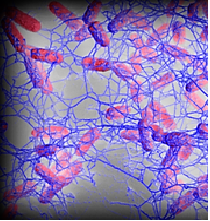L. Wu et al. (J Food Prot (2021) 84 (6): 1060–1068.) compared Beef extract (BE) Medium to Tryptic soy broth (TSB) in minimally processed food models to study the effects on Escherichia coli O157:H7 biofilm formation. They studied the effects of temperatures (4, 10, 25, 37, and 42°C), pH values (4.5, 5.0, 5.5, 6.0, 7.0, and 8.0), strain characteristics, and the expression of functional genes on the biofilm formation. The three E. coli O157:H7 strains produced biofilm in both media. However, the biofilm formation was greater in BE than in TSB (P < 0.05). The strongest biofilm formation of E. coli O157:H7 was achieved at 37°C and pH 7.0. Biofilm formation was significantly inhibited by incubation at 4°C. Biofilm formation was correlated with auto aggregation or hydrophobicity in BE (P < 0.05). At the initial stage of biofilm formation, the expressions of luxS, sdiA, csgD, csgA, flhC, adrA, and rpoS were significantly higher in BE than in TSB (P < 0.05). At the maturity stage, the expressions of luxS, sdiA, csgD, csgA, flhC, csrA, adrB, adrA, iraM, and rpoS were significantly higher in TSB than in BE (P < 0.05). Such information could help develop effective biofilm removal technologies to deal with the risks of E. coli O157:H7 biofilms in the beef industry. @ https://meridian.allenpress.com/jfp/article-abstract/84/6/1060/452180/Beef-Based-Medium-Influences-Biofilm-Formation-of?redirectedFrom=fulltext
Biofilm Formation of Escherichia coli O157:H7 Isolated from Beef Processing Plants
Beef-Based Medium Influences Biofilm Formation of Escherichia coli O157:H7 Isolated from Beef Processing Plants | Journal of Food Protection
No comments

